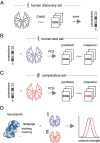Human and chimpanzee shared and divergent neurobiological systems for general and specific cognitive brain functions
- PMID: 37216540
- PMCID: PMC10235977
- DOI: 10.1073/pnas.2218565120
Human and chimpanzee shared and divergent neurobiological systems for general and specific cognitive brain functions
Abstract
A long-standing topic of interest in human neurosciences is the understanding of the neurobiology underlying human cognition. Less commonly considered is to what extent such systems may be shared with other species. We examined individual variation in brain connectivity in the context of cognitive abilities in chimpanzees (n = 45) and humans in search of a conserved link between cognition and brain connectivity across the two species. Cognitive scores were assessed on a variety of behavioral tasks using chimpanzee- and human-specific cognitive test batteries, measuring aspects of cognition related to relational reasoning, processing speed, and problem solving in both species. We show that chimpanzees scoring higher on such cognitive skills display relatively strong connectivity among brain networks also associated with comparable cognitive abilities in the human group. We also identified divergence in brain networks that serve specialized functions across humans and chimpanzees, such as stronger language connectivity in humans and relatively more prominent connectivity between regions related to spatial working memory in chimpanzees. Our findings suggest that core neural systems of cognition may have evolved before the divergence of chimpanzees and humans, along with potential differential investments in other brain networks relating to specific functional specializations between the two species.
Keywords: MRI; brain; connectome; evolution; intelligence.
Conflict of interest statement
M.P.v.d.H. has served as a committee member of ERC evaluation council, acts as a consultant on a data project for ROCHE and is part of the Editorial board of Human Brain Mapping; there is no relationship or financial competing interest to the current project.
Figures



References
-
- McDaniel M. A., Big-brained people are smarter: A meta-analysis of the relationship between in vivo brain volume and intelligence. Intelligence 33, 337–346 (2005).
-
- Deary I. J., Penke L., Johnson W., The neuroscience of human intelligence differences. Nat. Rev. Neurosci. 11, 201–211 (2010). - PubMed
-
- Schnack H. G., et al. , Changes in thickness and surface area of the human cortex and their relationship with intelligence. Cereb. Cortex 25, 1608–1617 (2015). - PubMed
-
- Rilling J. K., Human and nonhuman primate brains: Are they allometrically scaled versions of the same design? Evol. Anthropol.: Issues News Rev. 15, 65–77 (2006).
Publication types
MeSH terms
Grants and funding
LinkOut - more resources
Full Text Sources

